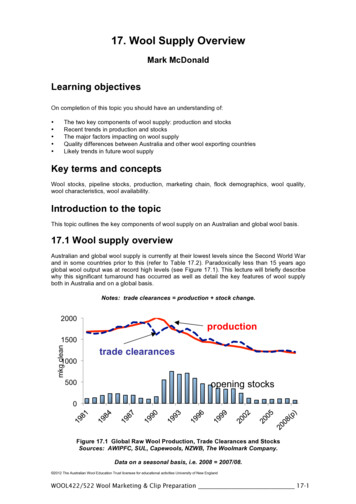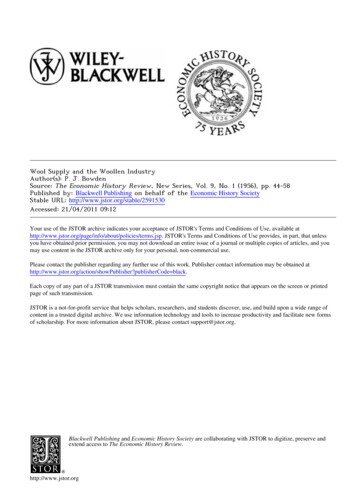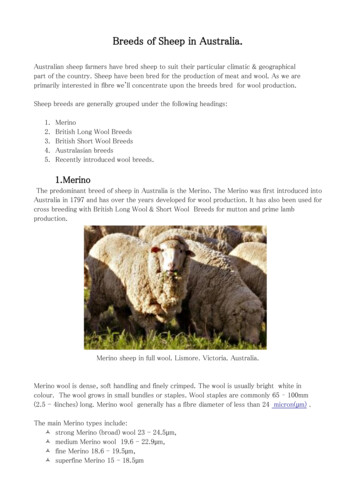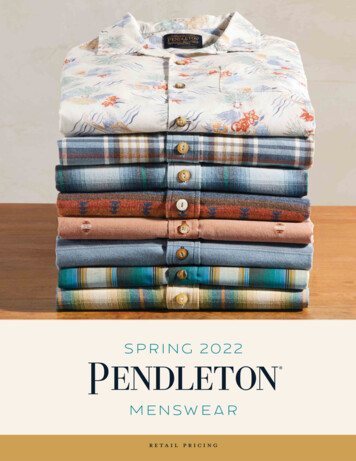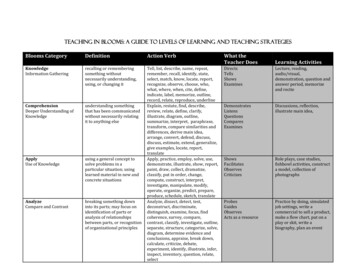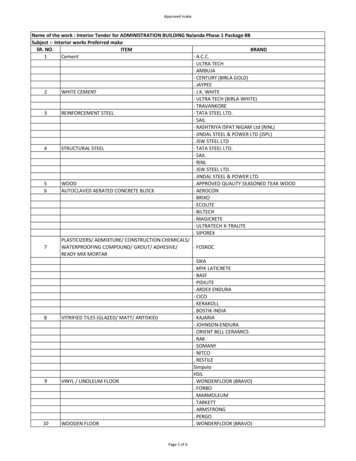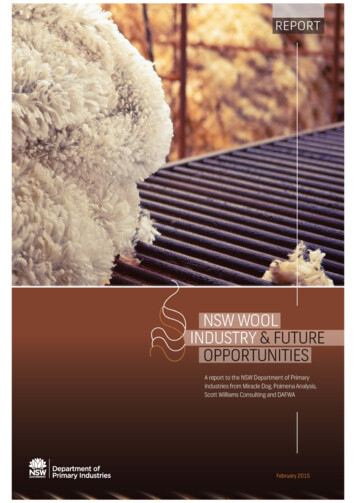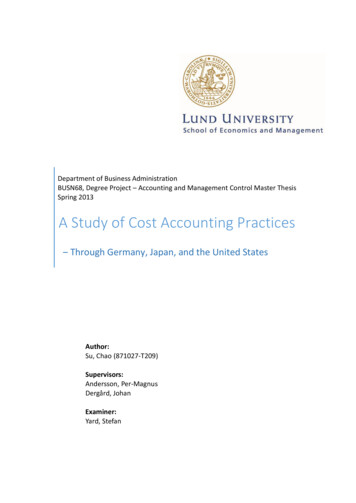
Transcription
AS3‐4.058Judging Wooland Mohair
ContentsWOOL . 3Shrinkage and Yield . 4Scoring . 4Bulkiness . 5Length . 5Soundness and Purity . 5Quality . 7Character . 7Color . 7MOHAIR . 7Grading . 7Scoring . 7Fineness and Uniformity . 7Staple Length. 10Character . 10Softness . 10Luster . 10Condition or Yield . 10Purity . 10Color . 10INSTRUCTIONS FOR GRADING . 14Judging Card for Wool . 14Wool and Mohair Placing Cards . 14Judging Card for Mohair . 14DEFINITIONS . 152
Judging Wool and MohairJack L. Groff and George AhlschwedeExtension Sheep and Goat SpecialistsThe Texas A&M SystemTexas produces about 20 percent of the total wool clipand more than 97 percent of the total mohair clip of theUnited States. These two products contribute about 50million dollars annually to the agricultural income ofTexas.A producer with a good knowledge of wool andmohair encounters fewer problems in production andmarketing. Reliable information on the grades and qualityof wool and mohair helps ranchers calculate the truevalue of these products. They also are better able to planand execute breeding programs through which they canproduce the most popular and profitable types of wooland mohair.WoolThere are approximately 20 popular breeds of sheep,together with a great many less important breeds andcrossbreds, in the United States. The wool produced bythese sheep varies from very fine to extremely coarseand from 1 inch to as much as 12 inches in length for agrowing period of 12 months.For yarn to be uniform, the wool from which it ismade must be uniform, particularly as to length andfineness. The wide variation in the wool produced, plusthe need for uniform fiber, gives a basis for present-daygrades of wool. These grades are arbitrary divisionsmade primarily according to fineness and length. Lessimportant points that may have some influence on thegrade include soundness, purity, character, color andcondition. A wool grader considers all these points whengrading. Clean wool content, fineness, length of stapleand strength are the main characteristics considered inarriving at the value of wool.Grading means the placing of entire fleeces in theirgrade piles according to fineness and length. Whenfleeces contain more than one grade of wool, the graderplaces the fleece in the grade pile representing themajority of fineness and length. Therefore, each fleecehas to be examined in several places.There are six grades of wool according to fineness:fine, 1/2 blood, 3/8 blood, 1/4 blood, low 1/4 blood andbraid. These are only names of grades and do notindicate the breeding of the sheep.Learning to judge and grade wool and mohair helps ranchers to implement breeding programs that produce the most profitable typesof wool and mohair.3
The length of staple is measured from the base to thetip of the unstretched fiber. There are three main gradesaccording to length: clothing, French combing and staple.Clothing wools are the short-stapled wools within a gradethat are too short to be combed and are used in thewoolen system of manufacturing. French combing woolsare of medium length within a grade and may be combedon the French combs. The staple wools are the longestwools within a grade and are suitable for combing on theNoble combs. As a general rule, clothing wools bring thelowest price per clean pound, with French combingslightly higher and staple wool bringing the highest priceper clean pound within a certain grade.Various combinations of grades for fineness andlength can now be made, for instance, fine clothing, fineFrench combing and fine staple.Following are the grades of wool according tofineness and length in inches. These lengths do notcorrespond with the ones suggested in the USDAstandards, but come closer to meeting the requirementsof the wool trade and manufacturer.GRADES(Fineness)GRADE(Length)LENGTH ININCHESClothingFrench combingStaple2 and under2–33 and over½ bloodClothingFrench combingStaple2 ½ and under2½ –3½3 ½ and over⅜ blood*ClothingStapleUnder 3 ¼Over 3 ¼¼ bloodClothingStapleUnder 44 and overLow ¼ bloodClothingStapleUnder 4 ¼4 ¼ and overBraidClothingStapleUnder 4 ½4 ½ and overFine*ln the coarser grades of wool, the French combing lengthgrade usually is dropped because coarser, short wools areseldom combed with the French combs.Fineness in wool also can be designated by theBradford spinning count or numerical system, such as58’s, 60’s, and 64’s. The spinning count is determined bythe maximum spinning capacity of the wool. Theoretically,when wool is spun to the limit, the number of “hanks”weighing 1 pound equals the spinning count. A worstedhank contains 560 yards of yarn. Next, the hanks of yarnare placed on a scale until 1 pound of wool is represented.The hanks are counted to get the spinning count. Thespinning count system is more accurate and more widelyused than our system of grading. Length grades may becombined with these spinning sounds; for example, 64’sstaple, 64’s French combing and 64’s clothing.Following are the tentative grades of wool with theirspinning count equivalents according to the manual ofAmerican Society for Testing Material:Fine – 64’s, 70’s, 80’s½ blood – 60’s, 62’s3/8 blood – 58’s, 56’s¼ blood – 50’s, 54’sLow ¼ blood – 46’s, 48’sBraid – 36’s, 40’s, 44’sSHRINKAGE AND YIELD“Shrinkage” is a term commonly used with wool andrefers to the amount of foreign material found in greasewool, expressed as a percentage of the original greaseweight. “Yield” is the amount of clean wool left in a lotafter scouring, expressed as a percentage of the originalweight. The average yield of fine wool in Texas is 50percent.Shrinkage is made up of wool grease, driedperspiration, sand, dirt, corral dust and vegetable mattersuch as burs, neddlegrass, chaff, seeds and twigs. Thewool grease and dried perspiration combined are referredto as “yolk.”Yield is extremely variable and is influenced by factorssuch as the breeding of the sheep, manner of handling,amount of range cover, amount of wind, rate of stocking,soil type, type and amount of feed and other factors.Since yield is affected by so many factors, there is a widespread in the yield of wools. A variation in yield affects thegrease price; wool can have low yield and still be ofexcellent quality.Yield usually is estimated by visual examination. Foraccuracy, it is necessary to scour the wool and of properlytaken sample. Pressing the fleece together with the handsand observing the space occupied, together with theweight, gives a rough estimate of the yield. The length ofstaple and depth of dirt penetration are other guides towool yield. Examination of the dirt that can be shaken outof the fleece usually gives a good indication of yield; sandand dirt are associated with low yield, while corral dustand vegetable matter, such as chaff, are usually light anddo not contribute greatly to shrinkage.State and national wood judging contests require thatthe yield be indicated as high, medium or low. Highyielding fleeces yield more than 53%; medium-yieldingfleeces, 45 to 53%; and low-yielding fleeces, less than45% clean fiber.SCORINGThe state wool judging contests include theclassification of 20 fleeces of wool according to fineness,length and yield. Each fleece should be checked in threedifferent places on the form provided. Strength is oftremendous importance in wool manufacture, but is notconsidered in placing the grade for length on the 20fleeces4
to consider in judging wool. Estimated weight of cleanwool is given the largest number of points. Ranchmen getpaid for the number of pounds of clean wool they produce.A high-grease fleece weight does not necessarily mean ahigh-clean fleece weight. Ranchers should be able toestimate the amount of clean wool in a fleece.BulkinessBulkiness of fleece generally indicates a high yield ofclean wool. Squeezing the fleece together with the handsmay help you estimate clean wool. If you are able tocompress the fleece so that your hands close together, theyield of clean wool will be low.LengthSheep and goat specialists and local warehousemen selectfleeces for judging and determine score value.Length is given the second largest number of points.Longer stapled wools are more valuable and staple lengthadds weight to a fleece more than any other characteristic.Staple length is determined by measuring the unstretchedlength of the locks from base to tip. The length should bemeasured at several places over the fleece.fleeces. It is more important to look for fineness, lengthand yield than to spend time hunting for breaks. Scoringis on the basis of 5 points for fineness, 3 points for lengthand 2 points for yield, or 10 points per fleece. A samplescore card is shown on page 6.The state contests require the placing of two classes ofwool of four fleeces each. The placings should be madeand the numbers inserted. Scoring is based on 50 pointsfor placing and 50 points for reasons. This gives a total of200 points for the two classes.A score card (page 8) helps evaluate the various pointsThe staple length of wool is estimated by comparing it to theknown length to the joints of the thumb.Soundness and PurityFleeces are evaluated to determine placing order in a group-offour class.Soundness and purity rank high in number of points.Soundness refers to the strength of the wool fiber. Twotypes of defects affect the strength of wool. One is termedtender wool, which is wool that is weak throughout thelength of the fiber. The other is wool showing a break.When a lock is stretched and all the fibers break squarelyacross at the same point, it is termed a “break.” Breaksusually are caused by fevers or sudden changes; forexample, difficulty at lambing time, a bad case of screwworms, udder trouble, a sudden change to concentratedfeed, severe storms and freezing temperatures.5
NAME OR NO.AS3-4.055(Senior)WOOL GRADING SHEETFinenessFleeceNumberFineStaple Length⅜½¼Blood Blood BloodStapleFrenchCombing 1617181920Score: 200 total possible pointsTotal ScoreCorrect checks receive 4 points for fineness, 3 points for length and 3 points for shrinkage.Yield:High – over 53%Medium – 45 to 53%Low – under 45%6
MohairThere are not as many different uses for mohair as forwool, but mohair must meet the same generalrequirements as wool to be suitable for manufacture.When all the fibers break at the same place in the staple of thewool, it is called a “break”.The quality of mohair varies widely within flocks andwithin individual fleeces. This brings up the need forgrades so that it may be separated according to finenessand length. The trade has developed a set of grades thatis well recognized, however. The grades are basedprimarily on fineness and length, with minor attentiongiven to character, luster, condition, strength and purity.These grades have been derived from the AmericanSociety for Testing Materials tentative specifications formohair top.Purity refers to kemp and black fibers, both of whichcut down greatly on the value of wool. A large amount ofkemp increases the loss through breakage and unevendyeing while black fiber limits the use of the wool to themanufacture of dark-colored fabrics.Spinning counts are derived in the same manner as forwool; that is, the number of hanks of yarn that it takes toweigh 1 pound. Grades of mohair, together with theirspinning counts equivalents, are: kid 1, d36’s and 40’s;kid 2, 30’s and 32’s; adult 1, 26’s and 28’s; adult 2, 22’sand 24’s; adult 3, 18’s and 20’s; adult 4, coarser than 18’s.In addition, there are the usual off grades, such as burry,kempy, grey, cotted and stained.QualityQuality or fineness is next in importance. Fleecesshould be uniform in fineness over the entire fleece.Fleeces lacking uniformity require more preparation formanufacture, thus increasing the cost.CharacterCharacter refers to general appearance and crimp.Crimp refers to the natural waviness of the wool fiber.Wool that has good crimp usually has more strength andgoes through the manufacturing processes with lessbreakage.ColorColor is important to the manufacturer because if woolis to be made into white or light-colored fabrics, it mustappear white to creamy white. A large amount of stainedwool decreases the value of the fleece.Color of wool should not be confused with color of theyolk. Fleeces may appear yellow because of the color ofthe yolk, which varies from almost clear to a dark yellow.The score card on page 8 has been prepared to serveas a guide in wool judging.A sample placing and reason card is shown on page 9.The placing of the class is indicated at the top of the page.Under the number column, insert the fleece number thatbest represents the fleece description. That is, longestfleece number – number 2, shortest fleece number –number 4, etc. Only one number should be inserted ineach blank. In case of tie, the official judge will permitcredit for more than one answer for fleeces very similar inquality.GRADINGThe designated grades are based on fineness and noton the age of the goat producing the hair. It is possible foran adult goat to produce kid hair and for a kid goat toproduce adult hair. As a general rule, however, themohair becomes coarser as the goat gets older and,consequently, most of the finer hair will be produced by kidgoats.Reference to flat and ringlet type of mohair has beenavoided purposely. Many fleeces cannot classify as eitherof these two types. It is possible to produce high-qualitymohair in both the ringlet and flatlock types. One of theobjectives in mohair judging is to be able to determine thequality of the mohair regardless of the type of lock.Following is a sample classification card for mohair. Itis necessary for the contestant to check each sample inone column only.SCORINGIn addition to classifying 20 samples of mohair, thecontestant is required to place two classes of four fleeceseach and write the numbers. The score card, page 12,can assist the contestant in placing these classes.Fineness and UniformityFineness is given the largest number of points on thescore card. When mohair is sold on a graded basis, thefiner mohair sells for the highest price.It is important to the manufacturer that mohair fleecesbe as uniform as possible.7
SCORE CARD FOR WOOL JUDGINGPointsEstimated Clean Wool Content (yield and shrinkage) . 35High yield per fleece is desirable. Small amount of light-colored yolk as free from adhering sand, dirtand vegetable matter as possible. Cut heavily if tied with any twine other than paper.Length . 25Should be combing or staple length for the grade: i.e., fine, 3 in.; ½ blood, 3-½ in.; ⅜ blood, 3-¾ in.; ¼blood, 4 in.; low ¼ blood, 4-¼ in.; braid, 4-½ in. Lengths more than ½ inch greater than this are of noadditional value except increasing the yield and grease weight.Quality or Fineness . 10Should fall clearly in one of the grades according to fineness; i.e., fine, ½ blood; ⅜ blood; ¼ blood; low¼ blood; braid. Uniformity of fineness particularly desirable. Cut heavily for hairy britch.Soundness (strength) . 10Fiber should be strong throughout and free from breaks.Purity . 10Free from hair, kemp, black or brown fibers. Cut heavily for black or brown fibers and coarse, hairybritch.Character and Color (crimp) . 10Evenly crimped or wavy from base to tip. Crimp should be distinct. Free from frowsy wool. Soft andspringy to the touch. White to cream, bright color most desirable. Should be free from stains and withan even distribution of yolk.TOTAL1008
NAME OR NO.AS3-4.057(Senior)WOOL PLACING AND REASONS SHEETClass No.Placing order1st2nd3rd4thReasons: list the number of the fleece which matches the fleece description belowFleece DescriptionNumberLongest staple fleeceShortest staple fleeceFleece most uniform in staple lengthFleece most uniform in fineness (fiber diameter)Coarsest fleece in classHeaviest grease fleece weightLightest grease fleece weightFleece with most pounds of clean woolFleece with least pounds of clean woolHighest yielding fleeceLowest yielding fleeceFleece with the most character (color, crimp & condition)Fleece with the most vegetable matterFleece with the most stained woolFleece with the least fiber strengthFleece with no colored fibersReasons scoring: 50 total possible pointsPLACING SCOREDeduct 3 points for each incorrect answerREASON SCORE9
percent. In recent years many breeders have bred Angoragoats with fleeces containing much more oil than this.Some ranchmen have sprayed goats with oil to increasefleece weights. Fleeces with excessive amounts of oil,whether natural or artificially added, should bediscriminated against.PurityPurity refers to freedom from kemp or colored fibers, orboth.Kemp fibers are the chalky white hairs similar to thehair on the faces and lower legs that are found scatteredthrough the fleece. Kemp fibers are usually found on theback and thighs.They are undesirable to themanufacturer because they add to the waste throughbreakage in manufacture and present a problem in dyeing.ColorMany livestock judging contests require evaluation of live animalsas well as of fleeces.Good quality mohair should have a white color whenscoured. Dinginess or dullness in color detracts from thevalue. A large amount of stained mohair in the fleece willlower the color rating.Colored fibers are undesirable because they limit theuse of the mohair. Mohair containing colored fibers mustbe used in the manufacturer of dark-colored fabrics.Staple LengthStaple length in mohair is important to produce heavyfleece weights and a fiber with sufficient length forcombing. Good Angora goats should produce mohair atthe rate of 1 inch per month or a 6-inch staple for each ofthe 6-month shearings. Mohair with a staple length of 4inches is long enough for top making.CharacterCharacter usually refers to waviness and type of lock.Type of lock may be important to the registered breederbut is of little importance to the manufacturer. Character isimportant to the manufacturer because the fleeces withwell-defined locks go through the manufacturingmachinery with less breakage of fiber than fleeces lackingcharacter.SoftnessSoftness is often referred to as handle. Softer mohairmakes softer-handling fabrics. Harshness is undesirablefor the manufacture of high quality fabrics.LusterLuster is the brightness or shininess of the mohairfiber. Mohair with high luster, but otherwise equal inquality, is preferred over mohair with poor luster.Condition or YieldCondition or yield refers to the amount of clean mohairexpressed as a percentage of the original grease weight.Mohair should have a shrinkage of approximately 15This sample of high quality mohair has excellent character, lusterand yield.10
NAME OR NO.AS3-6.051MOHAIR GRADING SHEETFleeceNumberKidNo. 136’s – 40’sKidNo. 230’s – 32’sGrownNo. 126’s – 28’sGrownNo. 222’s – 24’sGrownNo. 318’s – 20’sand e: 200 total possible pointsTOTAL SCORECorrect checks receive 10 points, checks within one place of correct receive 5 points.11
SCORE CARD FOR MOHAIR JUDGINGPointsLength . 20Staple length is very important in mohair. Length should be 6-inch staple for 6-month growth.Fineness and Uniformity . 40Should fall into one of the recognized grades: kid 1, kid 2, adult 1, adult 2, adult 3 and adult 4. Shouldbe uniform in fineness throughout.Character . 10Character is denoted by waviness and the degree to which the locks are separated. Avoid straight fluffyhair that has no waviness.Softness . 5Mohair should have a soft handle, discriminate against mohair with a harsh handle.Luster . 5Luster is the shininess of mohair. Good mohair appears bright and shiny.Condition or Yield . 10Mohair does not have the wide variation in yield that is found in wool, Mohair should have a mediumamount of natural oil and be free from adhering dirt and vegetable matter. Cut heavily for oil that hasbeen added to the fleece artificially and for large amounts of vegetable defect.Purity . 10Should be free from kemp and colored fibers. Cut heavily for large amounts of either.TOTAL10012
NAME OR NO.AS3-4.052(Junior)MOHAIR PLACING AND REASONS SHEETClass No.Placing order1st2nd3rd4thReasons: list the number of the fleece which matches the fleece description belowFleece DescriptionNumberFinest fleece in classCoarsest fleece in classMost uniform in finenessLongest staple fleeceShortest staple fleeceMost uniform in staple lengthFleece with brightest lusterFleece with least lusterFleece with greatest softnessHeaviest grease fleece weightLightest grease fleece weightMost pounds of clean mohairLeast pounds of clean mohairFleece with most vegetable matterFleece with most stained mohairFleece with the most kempReasons scoring: 50 total possible pointsPLACING SCOREDeduct 3 points for each incorrect answerREASON SCORE13
A score card for use in judging classes of mohairfleeces is on page 12. A sample placing and reason cardis shown on page 13. The placing of the class should beindicated at the top of the page. Under the numbercolumn, insert the fleece number that best represents thefleece description; that is, longest staple fleece – number2, shortest staple fleece – number 4, etc. Only onenumber should be inserted in each blank. In case of tie,the official judge will permit credit for more than oneanswer for fleeces very similar in quality.Instructions for GradingJUDGING CARD FOR WOOLEach fleece is worth 10 points, with 4 points forfineness, 3 points for length and 3 points for shrinkage.Credit should be given for any part that is correct. In thisway, it is possible to get scores of 10, 7, 6, 4 or 3.There are arguments against this system mainlybecause if the grade for fineness is wrong, the grade forlength also may be wrong. This grading system has beenfollowed to allow the contestants to make higher scoresand provide encouragement and confidence.Total possible score would be 200 points for this part ofthe contest.not exceed 15 points. All possible placings can then bescored in the usual manner on the basis of 50 points forplacing.In cases of a complete error, or where there is nojustification for the placing, it may be desirable to score itas a bust with a score of – 12 for that particular column ofreasons. This generally would be in cases where thelowest fleece was placed over the top fleece and in somecases where the third-place fleece was placed over thetop fleece. In some cases it will not be desirable to usethis plan.The grading committee then can score numberschecked by the contestant. Deduct 3 points for eachincorrect reason number.Reason grades are figured on the basis of 50 points asperfect score. Deduct the total number of points lost from50 to obtain the reason score.JUDGING CARD FOR MOHAIREach fleece has a score of 10 points. Fineness is theonly point considered in grading mohair samples. If thesample is graded correctly, give it a score of 10. If thegrade marked is one place on either side of the correctgrade, allow 5 points. If it is off more than one grade oneither side of the correct grade, give a 0.WOOL AND MOHAIR PLACING CARDSKempsy samples should be marked kempy only. If agrade is marked in addition to kempy, 5 points should bededucted.The official judge should supply the scoring committeewith cuts or points difference between first and second,second and third and third and fourth. Total cuts shouldGiving 5 points for missing the sample by one gradeallows the contestant to make a somewhat higher scoreand provides some encouragement.Learning to judge wool and mohair is not easy; however, the national 4-H wool judgingcontest held in Texas each year provides extra incentive.14
DefinitionsBreak . Wool that is abnormally weak in one spot in the staple length of the wool.Breech or britch . Coarse hair-like fibers on the lower hind legs and around the dock of some sheep.Character . General appearance of the wool or mohair with special reference to the possession of crimp.Clip . Wool or mohair produced by one flock of sheep or Angora goats.Clothing wool . Wool that is not suited to combing and is used in the woolen system of manufacturing. Usually, wool ofshort fiber length.Color . A bright white to cream is the most desirable color of wool. Other colors are referred to as “off colors.”Condition . Amount of yolk contained in the fleece.Crimp . Natural curl or waviness of the fiber.Defect . Vegetable content of wool and mohair.Fleece . Wool or mohair produced by one sheep or Angora goat at one shearing.French combing . Wool or medium fiber length and suitable for combing on the French combs.Grading . Separating entire fleeces into groups according to fineness and length.Hank . A standard length of yarn, sometimes called a skein. In worsted yarn, a hank is 560 yards.Kemp . Opaque, hair-like fiber which is brittle and chalky white. It is a serious defect.Lock . A group of fibers clinging together within a fleece.Luster . Shininess of the fiber or its ability to reflect light.Noils . The short fibers removed from the long ones in the combing process.Purity . Freedom from off-type fibers, such as hair, kemp and colored fibers.Quality . A term used in the wool trade to indicate fineness.Shrinkage . The weight raw wool loses when scoured, expressed as a percentage of the original weight.Sorting. Breaking up individual fleeces into various grades determined by their fineness and length.Soundness . Strength of the fiber or freedom from breaks and tenderness.Spinning count . The number applied to wool indicating the fineness of the yarn which can be spun from it. The numbersare derived from the number of hanks of 500 yards each that are required to weigh 1 pound.Staple wool . Wool with suitable fiber length to permit it to be combed on the Noble combs. Wools with excellentlength within a grade for fineness.Tags .
staple, 64's French combing and 64's clothing. Following are the tentative grades of wool with their spinning count equivalents according to the manual of American Society for Testing Material: Fine - 64's, 70's, 80's ½ blood - 60's, 62's 3/8 blood - 58's, 56's
